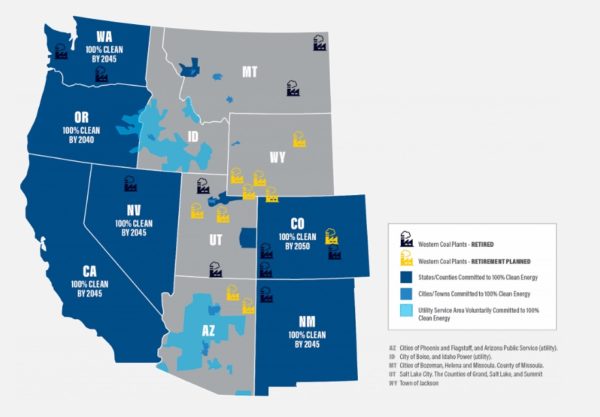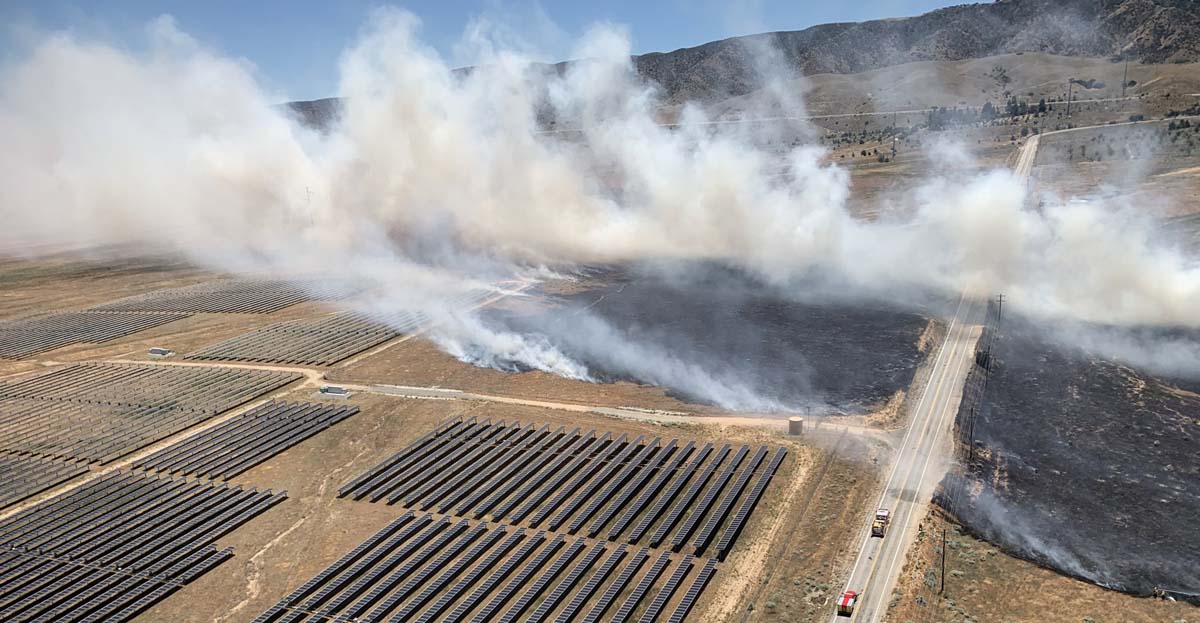The “Lights on California” coalition was launched by well-known names in the clean energy industry as well as environmental advocates. The group is committed to expanding renewable energy cooperation across the West, and it intends to raise awareness of the state’s options for a more affordable, reliable clean energy grid through participation in a regional transmission organization (RTO).
An RTO is an independent, membership-based, non-profit organization that operates multi-state electricity grids, oversees regional wholesale electricity markets, and provides reliability planning for the region.
“The entire Western U.S. continues to grapple with extreme heat, fires, and a diminishing water supply. All of which impact the reliability of our energy system. We simply cannot afford to be left behind as the rest of the West looks for regional solutions that will enhance reliability,” says Brady Van Engelen, policy advocate on energy and climate for the California Chamber of Commerce. “An RTO is clearly one of the best ways to deliver it, providing a framework for tapping into vast wind, solar, and other reliable, low-cost clean energy supplies across the West, while creating more high-paying jobs for Californians.”
The coalition notes that today, 80% of energy customers in the West are served by utilities with net-zero carbon energy mandates. With the shift away from fossil fuels, California has a new opportunity to work with its neighbors to overcome its energy challenges by participating at the RTO level. Five western states have passed laws requiring participation in an RTO or are actively engaged in RTO discussions. Meanwhile, an existing RTO, the Arkansas-based Southwest Power Pool, is asking western states to join. The coalition argues it would rather have California lead a western RTO effort than risk being isolated from one.

While California has led the nation in setting ambitious 100% clean energy targets, the annual threats of summer blackouts and spiking winter heating costs continue to highlight just how much more clean power will be needed to keep the lights on and energy bills affordable. One recent state analysis found California will need to increase by nearly five-fold the amount of renewable energy it brings online each year to achieve 100% clean energy by 2045. Building the necessary amount of wind and solar power to meet this demand, another study found, would require 6,280 square miles—an area bigger than the State of Connecticut, and likely more land than California has available.
The “Lights On California” coalition is concerned about clean energy solutions both within and beyond California, as the west is one of the only regions in the country without shared governance of the regional power grid to help bring clean energy resources online. In other parts of the country, seven RTOs cover about half of U.S. states and meet two-thirds of national energy demand—helping coordinate energy reliability planning, manage wholesale electricity markets, and effectively operate electricity grids across state lines. Out west, 38 different balancing authorities manage the region’s energy grid, according to the coalition.
“An RTO is a critical building block to integrate and coordinate the long-term transmission planning and investments necessary to boost renewable power development and achieve California’s clean energy goals reliably and affordably, said Alex Jackson, director of American Clean Power-California.
California imports nearly a third of its power, and it depends on out-of-state clean energy in times of need. During the September 2022 heatwave, for example, CAISO reported that California kept the lights on by importing 7,500 MW of hydropower from the Pacific Northwest when smoky air from wildfires hampered solar production. The coalition notes, however, that energy margins were thin as market barriers prevented the state from tapping additional clean power from Arizona and New Mexico.
The coalition believes that an RTO can help California avoid future energy emergencies, allowing grid managers to work more closely with neighboring states to plan energy deliveries further ahead, deliver power reliably and at lower cost, invest in new solar, wind, and other resources, and build the interstate transmission lines needed to connect far-flung renewable projects with consumers. A new report from Advanced Energy United concludes an RTO of 11 western states would save Californians up to $563 million in annual energy bill savings, create 138,700 new high-paying jobs (averaging $91,000 in annual compensation), produce $21.7 billion in economic growth, and accelerate 470 MW of new clean energy construction.
To better understand the state’s regional energy options, the California legislature has requested a report in February from CAISO and the National Renewable Energy Laboratory (NREL) on how an RTO can help California achieve its energy and environmental goals. The report is the result of a resolution, ACR 188, which passed unanimously by the Assembly and Senate last year. A draft of the CAISO/NREL report released in January found “California’s goals for renewable energy and greenhouse gas reduction can be achieved faster and with less cost to Californians through expanded regional cooperation.”
“California can and should develop all of the renewable resources it can within its borders, but that won’t be enough to stay ahead of climate change,” said Victoria Rome, director of California Government Affairs for the Natural Resources Defense Council. “An RTO is the structure the West needs to plan and invest in the modern transmission system that can make our clean energy future possible.”
As the legislature considers how best to act on the CAISO/NREL findings, the coalition will be raising awareness on the benefits of an RTO for consumers, businesses, workers, and the environment.
“It was brave when California stood alone in committing to a clean energy future. That time has passed, and we are fortunate to have a lot of company,” said V. John White, executive director of the Center for Energy Efficiency and Renewable Technologies. “Now our shared success depends on finding ways to cooperate to deliver the clean power Californians and our neighbors are going to depend on for years to come.”
A full list of current “Lights On California” coalition members can be found below. More information is available at: LightsOnCA.org.
- Advanced Energy United
- American Clean Power-California
- California Chamber of Commerce
- Center for Energy Efficiency and Renewable Technologies
- Clean Power Campaign
- Environmental Defense Fund
- Independent Energy Producers Association
- NRDC
- Solar Energy Industries Association
- Western Freedom
This content is protected by copyright and may not be reused. If you want to cooperate with us and would like to reuse some of our content, please contact: editors@pv-magazine.com.









Hi. I am – and – am not surprised to see NRDC and EDF listed as in support of utility-required RTOs. I give money, – not a lot, because I am low on money, – to organizations which are standing against DOI permitting last century utility scale solar “large arrays” infrastructure onto remaining irreproducible, irreplaceable natural wildlands of the Mojave Desert. I oppose US and transnational financiering corporations coming into the Mojave to destroy it, with laddered 30-40yr use life projects, soon or already rendered irrelevant, unacceptably unprofitable in comparison to quickly evolving photovoltaics, tech and business models. – We will have better transmission security with the modular, Microgrid concept. (Recent RK piece: military chooses greener, less destructive – Microgrid – and – not – the “Links”, for its own priorities. Its operations require non-problematic energy collection, transmission, storage and distribution, with best flexibility and reliability). I have heard there was a chance for the Mojave to be spared being scraped, when the utilities were divvying up territories…but our Mojave (not lush and green), was not protected. It got written off by EDF, TNC, TWS – and NRDC? Easier for them to get money to other threatened ecosystems: don’t waste time and money trying to defend an essential, singular ancient desert, without the pandas, elephants, big cats or dolphins…
PS Information you all at PVMagazine give us, (which I look for every morning – we are in a race out here), continues to indicate, “30-40 yr use life” utility corporation “large array” and Link projects, will not be finished in permitting process, before they are understood by everyone – finally – to not be worth the wrecking of actually valuable ecosystems. I hope the last 1990s hold outs for construction prep realize we need the desert, and we don’t need any “large arrays” – in time.
Microgrids are great for small isolated islands, like a military base but to propose microgrids as a solution for utility scale consumption is quite misleading. Rooftop solar is not a solution for most residents, if it was the credit system would be unnecessary and the systems would sell themselves.
Public land is for public use, there are millions of acres set aside for ZERO development, wilderness areas, ACEC, NPS, NFS, Monuments, etc. Large companies with footprints in multiple states are pushing the RTO because they can ship cheap power from WY, MT, UT, ID to CA. If the residents of WY, MT, UT, and ID are okay with, well what can you say.
Please ditch the “not in my backyard” attitude, which extends everywhere renewable energy is proposed. PV arrays are completely modular, as new panels with greater energy density are placed on the same rack as the old array.
Why be so picky on where the money comes from, be in native or imported $$ it all spends the same, construction jobs, operation jobs, permitting jobs, independent contractor jobs, etc. The Mojave preserve is over a million acres, how much more do you need!